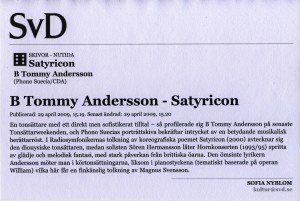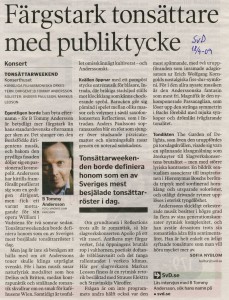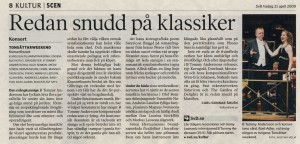Reviews — Composer
SELECTION
See also: Reviews — Conductor
Concert reviews: first performance of Pan at the Proms, 3 September 2015 (Prom 64)
BBC National Orchestra of Wales, conducted by Thomas Søndergård, Royal Albert Hall, London, 3 September 2015
“The new works of [Anders] Hillborg and Andersson were among some of the most exciting music heard on this season’s Proms. Both benefited from astute programming: Hillborg’s Beast Sampler was paired with Sibelius’s Tapiola, and Andersson’s Pan with excerpts from Nielsen’s incidental music for Aladdin. […]
B Tommy Andersson’s well-received Pan presented a character portrait of the Greek god. It captured something of the complex, multidimensional depictions of Pan, the seductive as well as the chaotic aspects. Andersson citing as inspirations portrayals from Greek mythology through to the Italian painter Roberto Ferri (b. 1978). The driving dance rhythms in Nielsen’s ‘Dance to the Prisoner’ complemented the violence of the opening of Pan, and the BBC National Orchestra of Wales, led by Thomas Søndergård, gave un exhilarating performance of both works. Andersson’s close collaboration with the orchestra as Composer-in-Association was evident from the outset, and the organ blended beautifully, with David Goode’s sensitive rendering of the part never overpowering the rest of the instruments. This was particularly impressive given the acoustic in the Royal Albert Hall and the sheer size of the organ, which can easily dominate (an intermittent problem in Jón Leifs’s Organ Concerto, performed on the same evening as Beast Sampler). The work alternates between brutality and languid sensuousness, passages of wild bacchanalia framing sections of more delicate, intimate orchestration. A particularly memorable moment came towards the close of the piece in the cello solo (played by Rebecca Gilliver), signaling the return of the opening chord on the organ, now subdued, beneath a solo piccolo. Pan is momentarily sated before the final climax begins, growing from the pulse in the bass instruments, the heartbeat of the sleeping orchestra slowly increasing to the final wild frenzy. […]
With anniversary celebrations falling so close to one other, the orchestral music of Stravinsky, Sibelius and Nielsen has dominated concert halls in the last couple of years. Scheduling new works alongside provided a fresh perspective on this repertoire; I heard Tapiola anew when played next to Beast Sampler, and found the dance rhythms from Aladdin to take on greater urgency in light of Andersson’s Pan.”
(Leah Broad, Tempo 70 — A Quarterly Review of New Music, Cambridge Journals, December 2015)
—————
“And in the BBC National Orchestra of Wales’s Prom under Thomas Søndergård I was blown away, almost literally, by the rude blasts and dancing vitality of Pan, a new 20-minute work for organ (the excellent David Goode) and orchestra by B Tommy Andersson.”
(Richard Morrison, The Times, 7 September 2015)
—————
“Thus we were prepared for the explosion that is B Tommy Andersson’s Pan. What a showpiece this is, making full use of the Royal Albert Hall organ and the sense of occasion that is the essence of the Proms. Grand fortes suddenly transforming into delicate ppp’s, from which a solo violin emerges, lit by bell-like sonorities, introducing a lovely flute melody. This is Pan, doing his individualist thing, surrounded by nature. Yet Pan is part man, part goat, and symbolizes animal instincts. So the music rises to riotous crescendo, the organ (David Goode) dancing joyously with the orchestra. Gosh this was good fun, and very well executed too. On a First Night, this would have knocked the audience out, in a good way.. Pan is a welcome change from the corporate mediocrity that curses so much newly written but not new music at the Proms.”
(Classical Iconoclast, 4 September 2015)
—————
“Andersson’s Pan is scored for organ and large orchestra — the organ an integral part, becoming enormous Pan-pipes — lasts about 20 minutes. In Classical times fear was the predominant emotion when Pan was around, hence the Greek word panikon and Andersson’s work plays on this, much of it exploding into a kind of visceral unpredictable chase underpinned by a feeling of immense power barely contained.”
(Douglas Cooksey, Classical Source, 3 September 2015)
—————
“Here was an unashamedly lush orchestral showpiece that kept Ravel and his “choreographic poem” La valse in the rear-view mirror. Even the French master of orchestration rarely indulged effects so lavish and he never threw in a big supporting role for organ. Andersson’s programme note talked about being inspired by ancient statues of the god Pan. What we heard sounded more like Daphnis and Chloe waltzing feverishly round a deserted cathedral to the accompaniment of a crazed organist. Extravagant and huge, it filled the Royal Albert Hall entertainingly enough for 20 minutes.”
(Richard Fairman, Financial Times, 6 September 2015)
Concert review: BBC NOW plays Satyricon, 4 June 2015
BBC National Orchestra of Wales, conducted by Thomas Søndergård, St. David’s Hall, Cardiff, 4 June 2015
” ‘Conductor’s music’ isn’t always used as a term of praise, and can refer to flashy, shallow showpieces, more dazzle and display than substance and structure. That doesn’t have to be the case, though. Both works in this, the final concert of the BBC National Orchestra of Wales’s season [B Tommy Andersson: Satyricon & Gustav Mahler: Symphony No. 2], were by composer-conductors, and showed distinctive signs of this in their virtuosic writing for huge orchestral forces, worthily realised by the orchestra and chorus under the baton of Thomas Søndergård, the orchestra’s Principal Conductor. B. Tommy Andersson is a Swedish composer and conductor who has been Composer-in-Association with the BBC National Orchestra of Wales for a productive and interesting season. His Satyricon, based on Petronius’s scabrous, sexually-explicit novel, is labelled as a ‘choreographic poem’ but might equally well serve as a ballet score. Andersson wrote it in memory of his friend the dancer and choreographer Per Jonsson.
…..Andersson is particularly fond of using large, complex percussion ensembles, and these drive the dance-like rhythms of Satyricon, with Spanish castanets, a ship’s brass bell, splash cymbal, tubular bells and log drum all adding to the passionate, tumultuous pace of the central sections. The opening is ‘secretive and quiet’, rustling in with glissandos on muted strings, but the pace soon picks up, taking on burlesque overtones in the central section. Andersson likes to use descending arpeggios as a kind of ostinato, and has other ostinato figures and sequences providing a useful means of navigating through the complexities of the score. The conclusion is an onslaught of full-orchestral sound, whipped up to an ‘exhilarated frenzy’ (the marking in the score at this point) by Søndergård, who clearly has a great affinity with Andersson’s music, and who has ably promoted it throughout this season.”
(Simon Rees, Wales Arts Review, 6 June 2015)
Concert reviews: BBC NOW plays The Garden of Delights, 3 October 2014
BBC National Orchestra of Wales, conducted by Thomas Søndergård, St. David’s Hall, Cardiff, 3 October 2014
“The concert opened with B Tommy Andersson’s The Garden of Delights, a tone poem based on the famous Hieronymus Bosch triptych, although the composer disclaimed any programmatic intention. But the opening was clearly a depiction of Hell, while the gentler central section was – if not Paradise – at least the Garden of Eden, with its chirruping songbirds sounding through the stillness recalling the depiction of The Garden of Love from Messiaen’s Turangalila Symphony if with rather more chastity. The long-breathed violin melody, with its almost Mantovani-like cascades of string tone, was particularly beautiful. The return of the ‘Hell’ music found the wood blocks ticking away like some sort of demented metronome, in a passage which surely was intended to illustrate one of the depictions in Bosch’s painting; but the conclusion, particularly after the long pastoral centrepiece, seemed curiously brief. The capacity audience, hardly any one of whom will have heard the piece before, were enthusiastic in their acclaim for the composer and the players, and the performance was simply stunning in both its virtuosity and its repose. One looks forward to further encounters with Andersson’s music (he has been appointed the orchestra’s composer in residence for this season) later in the year.”
(Paul Corfield Godfrey, Seen and Heard International, 5 October 2014)
—————
” ‘The garden of delights’ is five years old now and is the work of a composer comfortable with his craft. There was no gentle leading in, no preparing the audience… ‘The garden of delights’ exploded into the auditorium with crashes from the percussion and brass interspersed with frenzied strings, woodwind, horns and woodblocks. The first section brought together lots of different characters, each delightfully individual – squelching brass, insistent woodblocks, in blocks of sound gradually overlapping into a multi-faceted dance macabre. […] The next section was much calmer. Quiet legato brass were followed by airy held chords from the strings. More colours were added, trumpets and clarinets only to be interrupted by flute birds, woodblock woodpeckers, and other percussion animals. The legato sections expanded into close, bright, disharmony and a return to earlier ideas. A brief pause preceded a rising line from cello and tubular bells which after some development gave way to a sinuous oboe solo and more birds and led in turn to a general falling of the material. If the earlier rising section was dawn rising, this was the sun setting and the world going to sleep.
…..The final section was heralded by drums into a maelstrom of rolling thunder. Finishing much sooner than I expected, this was more like an extended coda than the third side of a tryptich. But then Anderssson was at pains to insist that the work was not a realisation of the painting – rather an interpretation of it, or of the feelings it produced in him.”
(Hilary Glover, Planet Hugill, 6 October 2014)
Concert review: Death in Venice, for orchestra (Richard Wagner in memoriam), first performance
The Orchestra of Norrlandsoperan, conducted by Rumon Gamba, Umeå Concert Hall, 16 January 2014
“Tonsättaren uppmanade publiken att låta sig sugas upp av stämningarna i stycket och det ödesmättade långsamt skridande stycket grep verkligen tag i en. En fantastisk klangvärld som förföljde oss hela vägen. Bravo!”
(Bengt Hultman, Västerbottens-kuriren, 17 January 2014)
Translation of the review:
The composer encouraged the audience to allow itself to get absorbed by the atmospheres in the piece, and this fateful, slowly progressing piece was really deeply affecting. A fantastic world of sounds that followed us all the way. Bravo!(Bengt Hultman, Västenbottens-kuriren, 17 January 2014)
Concert reviews: RSNO plays The Garden of Delights, October 2012
Royal Scottish National Orchestra, conducted by Thomas Søndergård
(Usher Hall, Edinburg, 26 October 2012 & Royal Concert Hall, Glasgow, 27 October 2012)
“It’s a nice sign that he [Søndergård] begins his first concert as Principal Guest with a work by his fellow Nordic musician, B Tommy Andersson, whose Garden of Delights was inspired by seeing Bosch’s painting of similar name in the Prado. Andersson structures his work similarly to the painting with a triptych of orchestral blocks: a lush, Romantic section coming between two faster, savage elements which I found very successful. The outer sections rely on thrusting, angular rhythms which are set against each other to exciting effect, while the rich central section relies on sensuality and atmosphere, with Mahlerian horn writing and meandering string lines suggesting Adam and Eve’s communion with God. It’s almost Brucknerian in the scale of the sound and its structural device of blocking contrasts of sound against one another…”
(Simon Thompson, Seen and Heard International, 27 October 2012)
—————
“The RSNO concert was a veritable ‘garden of delights’.
…..Such, in fact, is the title of Swedish composer B Tommy Andersson’s swirling musical representation of painter Hieronymus Bosch’s famous renaissance triptych, The Garden of Earthly Delights, which opened the programme. Placing it alongside Mahler’s Alpine-scented Blumine and Songs of a Wayfarer, and the rocky landscape of Sibelius’s Symphony No. 2, was tantamount to planning a musical botanical garden.
…..In charge of it all was RSNO principal guest conductor, Thomas Søndergård, carving out these exquisite landscapes with intuitive definition.
…..Andersson’s music opened and closed in a riot of color, the Danish conductor demanding unbridled attitude from the screaming horns and aggressive pizzicato basses at the outset, before allowing the music to settle into the central adagio, as impressionistic as Andersson’s persuasively gaunt language would allow.”
(Ken Walton, Scotsman, 29 October 2012)
—————
“The work is based on Hieronymus Bosch’s triptych The Garden of Earthly Delights, without being a panel-by-panel depiction. Although unmistakably tonal, there is such a energetically Boschian cornucopia involved that the sound world put me in mind of Ives with, perhaps, touches of Chavez or Revueltos. […] I would, however, love another opportunity to revisit this piece.”
(Alan Coady, Bachtrack, 29 October 2012)
CD review: The Garden of Delights, CD-revyn, Sveriges Radio P2, 20 May 2012
Mark: 5/5 = Exceptionally good
|
Here is a link to the broadcast review (in Swedish)
|
– Click on the image for a larger view
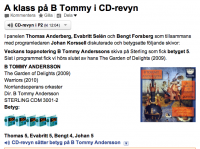

CD review: The Garden of Delights, Helsingborgs Dagblad, 20 June 2012
Mark: 4/5
|
– Click on the image for a larger view
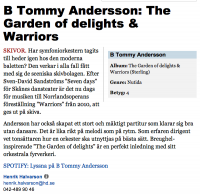
Translation of the review:
[…] Andersson has created a great and powerful score [Warriors], that very well manages to survive without dancers. It is just as rich in melody as it is in rhythm. Being an experienced conductor, the composer knows very well how to use an orchestra in the best possible way. Bosch-inspired “The Garden of Delights” is a perfect opening with its orchestral fireworks.(Henrik Halvarsson, Helsingborgs Dagblad, 20 June 2012)
CD review: The Garden of Delights, Sydsvenskan, 7 June 2012
Mark: 4/5
|
– Click on the image for a larger view
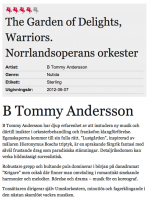
Translation of the review:
B Tommy Andersson has a long experience of conducting contemporary music, and also insights in the technique of orchestration, as well as in francophone timbre-seduction. All these qualifications are made justice. The Garden of Delights, inspired by the triptych of the painter Hieronymus Bosch, is a sparkling and colourful fantasy with tempestuous features, as well as paradisiacal atmospheres. The wealth of detail gives a visually surrealistic impression.
…..A more robust approach and a hammering pulse dominates in the beginning of the dance drama Warriors, but also here we find change in romantically caressing harmonies and melodies. Motion and drama — music for a choreographer.
…..The composer conducts the Umeå orchestra himself, meticulously and euphoniously, in this almost shamelessly beautiful music.(Sydsvenskan, 7 June 2012)
CD review: The Garden of Delights, Svenska Dagbladet, 30 May 2012
Mark: 4/6

Translation of the review:
More and more Swedish contemporary composers have lately returned to the first decades of the 20th century, sometimes even to Soviet modernism, without being occupied with postmodern stylistic games. B Tommy Andersson belongs to them, but unlike most of them, he has something to tell. As a conductor he knows from within how to create impressionistic and late-romantic orchestral sonorities, as well as how to sharpen brutality.
Translation of the review:
More and more Swedish contemporary composers have lately returned to the first decades of the 20th century, sometimes even to Soviet modernism, without being occupied with postmodern stylistic games. B Tommy Andersson belongs to them, but unlike most of them, he has something to tell. As a conductor he knows from within how to create impressionistic and late-romantic orchestral sonorities, as well as how to sharpen brutality.
(Erik Wallrup, Svenska Dagbladet, 20 May 2012)
Concert review: Toccata, Aria & Chaconne, Göteborgsposten, 1 August 2011
Styrsö Chamber Soloists, conducted by B Tommy Andersson, Styrsö Church, 31 July 2011
– Click on the image for a larger view
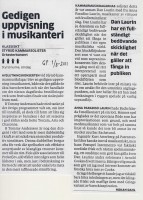
Translation of the review:
[…] B Tommy Andersson is probably the one conductor in our country that is most versatile by virtue of also being a prolific composer. These double skills vouch for works that are highly playable and efficiently make use of all musical resources. Personally, I felt associations with the music of Prokofiev, of course without any actual resemblances per se, but in the way the composer masters form, and in the ability to feed the most refined voice leading beneath a seemingly simple surface. […](Håkan Dahl, Göteborgsposten, 1 August 2011)
Concert review: The Garden of Delights, Helsingborgs Dagblad, 13 May 2011
Helsingborg Symphony Orchestra, conducted by Stefan Solyom, 12 May 2011
– Click on the image for a larger view
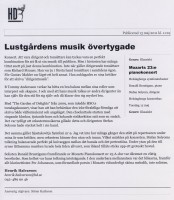
Translation of the review:
To be both a conductor and a composer is seemingly a perfect combination in order to get your music out to the audience. But historically, many critics have frowned at precisely this combination. Not when it comes to Richard Strauss, who in the eyes of his contemporaries mostly was considered a composer. But the situation was different for Gustav Mahler, who was accused of composing ‘Kapellmeistermusik’ (“conductor’s music”, a belittling term).
…..B Tommy Andersson seems to have found a good balance between his roles as interpreter and creator. Since his music is performed by other conductors, it has to stand on its own feet, which it does very well.
…..In The Garden of Delights (composed in 2009), which opened the concert last Thursday, he shows that he masters the art of composing well articulated music and with urgency. The shocking start, with ringing bells, howling horns, and boiling strings, was very precisely played. It was obvious that the orchestral musicians enjoyed the music and the conductor, Stefan Solyom, had the music entirely in his hand.”(Henrik Halvarson, Helsingborgs Dagblad, 13 May 2011)
Ballet review: Warriors, Västerbottens Folkblad, 4 December 2010
B Tommy Andersson: Warriors (Choreography: Pontus Lidberg)
The Orchestra of NorrlandsOperan, conducted by B. Tommy Andersson
Norrlandsoperan 3 & 4 December 2010
– Click on the image for a larger view
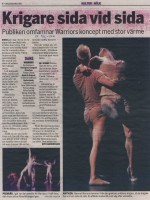
Translation of the review:
[…] Wow! What a fantastically beautiful dance performance! I felt a lump in my throat from strong emotions. On a scale ranging from one to ten, this performance must be a twelve. It simply has to be seen.(Ritu Andersson, Västerbottens Folkblad, 4 December 2010)
Concert review: The Garden of Delights/Concerto for Orchestra, Göteborgsposten, 16 August 2009
Gothenburg Symphony Orchestra, conducted by B Tommy Andersson
Outdoor concert at Götaplatsen, 15 August 2009
Programme: B Tommy Andersson: The Garden of Delights & Béla Bartók: Concerto for Orchestra
|
– Click on the image for a larger view
Translation of the review:
If someone, a few days ago, would have asked me for a recent Swedish orchestral piece with a capacity to match Bartók’s Concerto for Orchestra, I would have said that there is no such thing. Today, I know better.
…..B Tommy Andersson’s The Garden of Delights is, according to the composer himself, inspired by the fascination of Hieronymus Bosch’s fantastic triptych at the Prado Museum in Madrid.
…..Not that the music describes anything tangible, but surely one could hear the quiet left hand panel of the triptych, as well as the dramatic right hand panel, even though the composer himself emphasized the swarm of people and animals of the central panel in his short introduction.
…..Despite the rough weather, it became a distinguished artistic experience to hear this genuine orchestral music with such affluence of sound through the loudspeakers. In that way, the piece by B Tommy Andersson was in the same spirit as Concerto for Orchestra.
…..So, it hardly came as a complete surprise to me, that the conductor B Tommy Andersson also was able to interpret Bartók’s music successfully. If I have to bring out two things that have to work perfectly in order to have Concerto for Orchestra to reach through the loudspeakers in an outdoor venue such as this, it would be the mischievous rhythms and the originality of the orchestration. In both cases, conductor and orchestra made great achievements, which reflects an extremely professional attitude.
(Håkan Dahl, Göteborgsposten, 16 August 2009)
CD review: Satyricon, Hifi Magazine No. 6, 2009
Mark: 5/5 (Stig Jacobson)
|
– Click on the image for a larger view
Translation of the review:
Some time ago, there was a festival in the Stockholm Concert Hall with the music of B Tommy Andersson, conducted by himself. Foremost, he is mostly known as a conductor, but from now on, nobody can be doubtful about the fact that he is a composer to be reckoned with.
…..This is also proven by a recent CD with eight very impressive works of various kinds: two large orchestral works (Satyricon with the Radio Orchestra and a horn concerto with Sören Hermansson as a brilliant solist and the Helsingborg Symphony Orchestra) flanked by two lovely choral pieces with the Radio Choir and Ensemble Notus, and also piano pieces with Magnus Svensson. There is also a piece for soprano saxophone and orchestra with Anders Paulsson as a heartfelt soloist.
…..The music is skilfully composed, inspired and personal.
(Stig Jacobson, Hifi Magazine No. 6, 2009)
CD review: Satyricon, CD-Revyn, Sveriges Radio P2, 17 May 2009
Mark: 5/5 = Exceptionally good (from all four jurors)
|
Here is i link to the review (in Swedish)
|
– Click on the image for a larger view
CD review: Satyricon, Svenska Dagbladet, 29 April 2009
Mark: 6/6 (Sofia Nyblom)
|
– Click on the image for a larger view
Translation of the review:
A composer with an immediate and sophisticated voice — that is the distinctive image that B Tommy Andersson has created during the composer’s festival that took place this weekend, and the portrait CD from Phono Suecia supports the impression of an important musical story-teller. The Radio Orchestra’s interpretation of Satyricon shows the Dionysian composer, whereas the soloist Sören Hermansson allows the Concerto for Horn and Orchestra to bound for joy and melodic imagination, with a strong influence from the British Islands. One faces the tender-hearted poet Andersson in his choral compositions, as well as in his piano pieces (thematically based on his opera William), here delicately interpreted by Magnus Svensson.
(Sofia Nyblom, Svenska Dagbladet, 29 April 2009)
Concert review: Composer’s Festival ‘B Tommy Andersson’, Svenska Dagbladet, 18 April 2009
The Royal Stockholm Philharmonic Orchestra, conducted by B Tommy Andersson
Concert, 16 April 2009
(A composer’s festival, 16–19 April 2009, focusing on B Tommy Andersson’s music)
|
– Click on the image for a larger view
Translation of the review:
A COLOURFUL COMPOSER WITH POPULAR APPEAL
He should really change his name — because B Tommy Andersson is considerably more colourful than his common surname. The music of this conductor, born in Borås, is singing, and behind the neat facade hides a passionate cosmopolitan. Until now, Andersson has created a distinctive image of himself as a solid conductor, but his opera William was warmly received in Vadstena two summers ago. This composer’s festival should define him as one of the most inspired contemporary Swedish composers.
…..I am reluctant to consider his music as typically Swedish, as we find a poetical modality, as with Delius and Britten, whereas counterpoint and mellifluous Romanticism reveals a taste for the coffee rooms of Vienna. At the same time the tone is unmistakably cultivated — and Andersson-ish.
…..The evening starts with a stately piece of music for wind instruments, Intrada, where noisy city sounds are confronted with a bell sound that feels chockingly fragile. There are some baroque features in the interaction between mass and volume in the saxophone concerto as well as in Intrada. Anders Paulsson’s soprano saxophone becomes a voice singing above bouncing pizzicati and pleasurably raving through a composed solo cadenza.
…..If the basic character of Reflections is romantic, then Apollo carries a wild rage. The ancient myth colours the music, from the brutal call of the horns in the beginning and poetically sweet-scented passages for woodwind, to the heavy rallentando at the climax of the piece. Here the percussionist Markus Leoson lends refinement to a rhythmical rhetoric, closely related to Strauss’ Elektra and Stravinsky’s Rite of Spring.
…..The question is whether the second half of the concert was the most exciting, with two first performances surrounding the Adagio from Erich Wolfgang Korngold’s nostalgic Symphony in F-sharp. It is in the most recent music that Andersson’s imagination is the most free. The new Passacaglia is magnificent, dissolving the rigid symmetry of Bach’s piece into soft syncopations and dreamlike, sliding tonality.
…..The tone-poem The Garden of Delights, another premiere performance, turned out to be an exciting tone-painting, re-establishing the brutality of the percussion concerto, but with larger lyrical contrasts. A sensualism, full of imagery, forms associations with Hieronymus Bosch’s famous triptych, with muted horns, solo voices and impatiently pushing rhythms that dissolve in ethereal weightlessness.
…..Andersson’s skilfully orchestrated music has, to a greater degree than several of his contemporaries, a rhythmic complexity, and, despite his romantic vein, he refrains from sentimentality. He is simply an honest composer, that one wants to hear more of.
(Sofia Nyblom, Svenska Dagbladet, 18 April 2009)
Concert review: Composer’s Festival ‘B Tommy Andersson’, Svenska Dagbladet, 21 April 2009
The Royal Stockholm Philharmonic Orchestra, conducted by B Tommy Andersson
Concert, 18 April 2009
(A composer’s festival, 16–19 April 2009, focusing on B Tommy Andersson’s music)
|
– Click on the image for a larger view
Translation of the review:
ALREADY LITTLE SHORT OF CLASSICS
The versatile B Tommy Andersson has managed to live several parallel lives during his 45 years on this earth. Apart from an impressive lifework as a composer, he has had just as full a career as an orchestral- and opera-conductor.
…..If our peculiar music life had not been so complaisant to foreign concert managers, he would, since long, have been able to choose any Swedish symphony orchestra to become principal conductor. Perhaps the musicians would have discovered what a unique pedagogue and orchestral fosterer that would be included in the bargain.
…..In these sad circumstances, and the fact that his conducting technique does not play to the gallery, the courage of the Stockholm Concert Hall in deciding to let us spend an entire weekend with him in a kind of “This is your life”-perspective, is worth a special medal for great achievement.
…..During five hours of music, divided into 24 different pieces (of a total of 110 compositions), we have been amazed at how maturely B Tommy Andersson composed even at the age of 17. That his music is similarly rewarding to sing and play, does not mean that he is treading in old footsteps, because he always creates something unexpected from the old.
…..The reason why his choreographic poem Satyricon (based on fragments of a novel from the time of Nero) was such a success already at the first performance in 2004, was his ability to lead the energy of a late-romantic symphony orchestra into his own lines. Hardly a long line without cheeky syncopations and tantalizing rhythms picking on the melody.
…..During the last two concerts, we have been able to enjoy the sixteen infallible choristers from Olof Boman’s wonderful Ensemble Notus, the rich baritone voice of Andreas Landin, the delicate touch of pianist Magnus Svensson and a lovely duel between Dan Laurin’s recorder and Markus Leoson’s percussion instruments.
…..Nor shall we forget Sören Hermansson’s admirable flexibility in Concerto for Horn and Orchestra, even if his instrument did not sound as brilliant as in the portrait CD that was released by Phono Suecia this week.
…..Not a single one of the pieces performed during the festival have been redundant. After having studied the references of B Tommy Andersson, such as Korngold, Dowland, Messiaen and his teacher Sven-Eric Johanson, one often wished to hear some of the pieces one more time. But the orchestral pieces Satyricon and The Garden of Delights are already little short of classics.
(Carl-Gunnar Åhlén, Svenska Dagbladet, 21 April 2009)
Opera reviews: B Tommy Andersson’s opera William
Vadstena International Opera Academy, conducted by B Tommy Andersson (2006)
|
”B Tommy Anderssons ofta påfallande vackert melodiösa och sångbara musik lyfter fram Lindquists rakt berättande och konkreta text och skildrar emotionernas skiftningar, stämningar och stänk av tidsfärg. Orkestern spelar med stor sensibilitet, smekande stråkar och rytmisk skärpa, låter en rastlös oro pulsera genom känslospelet och tonmålar drömsekvenserna med harpa och piano. William är en intensivt hyperromantisk opera. I den centrala scenen när Williams hjärta svämmar över och hans svidande längtan bryter ner Marlowes försvarsmur så är musiken lika het som temperaturen i spellokalen, Bröllopssalen, i det solstekta slottet.”
(Karin Helander, Svenska Dagbladet, 28 July 2006)
Translation of the review:
B Tommy Andersson’s often strikingly beautiful, melodious, and singable music brings out [Håkan] Lindquist’s straightforward and tangible text, describing the emotional changes, the atmospheres, and gives contemporary colour. The orchestra plays with great sensibility, caressing strings and rhythmical precision, adding a restless pulse to the emotional state, and colours the dream sequences with harp and piano. William is an intensely hyper-romantic opera. In the central scene, where William’s heart exceeds all bounds and his heartbreaking yearning breaks down Marlowe’s defence, the music is just as hot as the temperature in the auditorium, the Wedding Hall, in the sun-heated castle.
(Karin Helander, Svenska Dagbladet, 28 July 2006)
—————
”Att tonsättaren som dirigent är väl förfaren att arbeta både med opera och med orkester är uppenbart. Här är det en praktiker som fört pennan. Han vet att skriva för rösterna, så att det låter bra, och han vet allt om hur puls och timing får en scen att leva. Han vet också att skapa pregnant instrumental bakgrund till det som händer på scenen liksom att göra musiken expressiv och attraktiv utan att den blir platt eller besvärande eklektisk. Man får omedelbart lust att höra den här operan igen. Därmed alltså sagt att B Tommy Anderssons debut som operatonsättare är mycket lyckad.”
(Lennart Bromander, Aftonbladet, 27 July 2006)
Translation of the review:
It is obvious that the composer, who is also a conductor, has experience of working with opera and with orchestra. It is a practitioner who has been holding the pen. He knows how to write for the voices in a way that they sound excellent, and he knows all about how to deal with pulse and timing in order to make a scene come to life. He also knows how to create an instrumental background to what is taking place on stage, as well as how to make the music expressive and attractive, without becoming trite or embarrassingly eclectic. One immediately wants to hear this opera again. This is to say that B Tommy Andersson’s debut as as opera composer is very successful.
(Lennart Bromander, Aftonbladet, 27 July 2006)
Concert review: B Tommy Andersson: Satyricon & Reflections
Satyricon: Swedish Radio Symphony Orchestra, conducted by Manfred Honeck
(Berwaldhallen, Stockholm, 23 April 2004)
Reflections: Jönköping Sinfonietta, conducted by B Tommy Andersson [Anders Paulsson, saxophone]
(Alseda Church, 3 April 2004)
|
”Tematiken — Roms förflutna — för tankarna till Respighis prunkande orkesterdikter och några ekon av Romerska fester finner man också i Satyricon. B Tommy Andersson har utnyttjat sina gedigna orkestererfarenheter till att komponera en bild- och färgrik musik, alltifrån inledningen, där träblåsarna en efter en träder fram över stråkmattan, över ett virvlande scherzoavsnitt och en kort lamentation fram till det backanaliska slutet. Den senromantiska klangapparaten utnyttjas med stor uppfinningsrikedom och B Tommy Andersson visar också en glädjande förmåga att foga in snabba moment i musiken; här är vi långt från de tunga block som präglat så många av modernismens tonbyggen.
…..Det gäller också för Reflections, den korta sopransaxofonkonsert som under tonsättarens ledning och med Anders Paulsson som solist uruppfördes av Jönköpings Sinfonietta för två veckor sedan. Med avstamp i en sång av John Dowland är det här ett mindre grällt men för den skull inte mindre virtuost stycke där Anderssons förmåga att att förena rytmik och melodik ger ett färgrikt och fascinerande resultat. Också här rör det sig i hög grad om musik i högt tempo: soprangirlanger över ett staccatoartat ackompanjemang.
…..B Tommy Andersson har med dessa verk visat sig vara en skicklig och underhållande tonsättare med förmåga att fängsla en stor publik, något man hoppas att andra institutioner tar fasta på.”
(Thomas Anderberg, Dagens Nyheter, April 2004)
Translation of the review:
The theme — Rome’s past — brings the the thoughts to Respighi’s dazzling tone poems, and some echoes from Feste Romane are to be found in Satyricon. B Tommy Andersson has used his solid orchestral experience to compose a visual and colourful music, all the way from the beginning, where the woodwind players one after another tread over the string chord, via a whirling scherzo, and a short lament, to the bacchanalian ending. The late-romantic apparatus in used with great inventiveness, and B Tommy Andersson shows a gratifying ability to incorporate fast elements in the music; we are here far from those heavy blocks that have been so significant for many of the creations of musical modernism.
…..This applies also to Reflections, the short soprano saxophone concerto that was first performed by Anders Paulsson and Jönköping Sinfonietta under the composer two weeks ago. With a song of John Dowland as a starting point, this is a less glaring but by no means less virtuoso piece, where Andersson’s ability to combine rhythm and melody gives a colourful and fascinating result. Even here it is to a high degree music in quick tempo: soprano garlands over a staccato accompaniment.…..B Tommy Andersson has with these works proved himself to be a skillful and entertaining composer with a capacity to captivate a large audience, something that one hopes that other institutions will notice.
(Thomas Anderberg, Dagens Nyheter, April 2004)
Concert review: B Tommy Andersson: Apollo
Göteborgs Symfoniker, conducted by Thomas Dausgaard [Markus Leoson, percussion]
(Gothenburg Concert Hall, 1998)|
|
”B Tommy Andersson är mest känd som dirigent hittills, men att döma av hans slagverkskonsert Apollo, tillskriven [Markus] Leoson, så lär det inte dröja länge förrän han är ett namn att räkna med också som tonsättare. Sällan har man hört ett så musikantiskt stycke nutidsmusik, ett verk så fyllt av spelglädje och god instrumentkännedom. Solostämman hade till övervägande delen icke melodibärande slagverksinstrument i centrum, men trots den begränsningen så levde verket högt på blandningen mellan suggestiva rytmer, mustiga klangsammansättningar och sångbara melodilinjer. Apollo i Anderssons tappning hade uppenbart dionysiska drag, någon annan slutsats kunde man inte dra efter en så livsbejakande upplevelse.”
(Håkan Dahl, Göteborgsposten)
Translation of the review:
B Tommy Andersson is mostly known as a conductor up to now, but judging from his percussion concerto Apollo, composed for [Markus] Leoson, it will not take long before he will be a name to reckon with also as a composer. I have rarely heard such a playful (musikantisch) contemporary piece, a work so full of zest and knowledge of the instruments. The solo part plays predominantely on instruments with no pitch, but despite this limitation, the piece thrives on a blend of suggestive rhythms, lush orchestrations, and singable melodies. Andersson’s version of Apollo clearly has Dionysioan features, that is the only conclusion one could draw from such a hedonistic experience.
(Håkan Dahl, Göteborgsposten, 1998)



